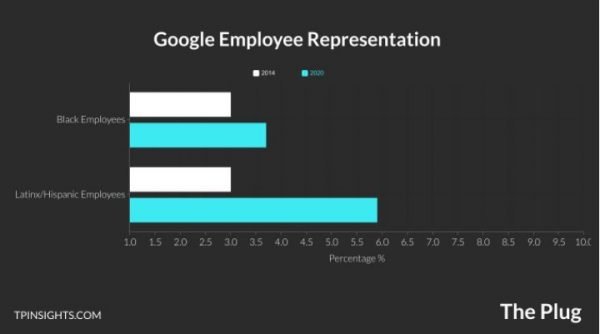At the start of the pandemic, some believed remote work could increase diversity for tech companies. Diverse talent was now accessible from all over the country, not just in costly coastal cities. But while working from home has increased the radius to find talent and brought tech companies to workers instead of the other way around, representation data and experts suggest remote work may not move the needle on racial representation.
The shift to remote work was done out of necessity (due to COVID-19) and not as an intentional strategy to increase racial and gender diversity in tech. Dr. Allison Scott, the Chief Executive Officer of the Kapor Foundation, along with Freada Kapor Klein, founding partner at Kapor Capital, told The Plug in a joint statement.
According to a report by As You Sow, a Berkeley-based non-profit shareholder advocacy group, tech companies still have a long way to go in terms of getting close to their goals set in 2014 for a more diverse workforce. The group ranked companies based on the amount of diversity, pay, and other disclosed information they’ve released, with the effectiveness of recruitment and employee retention rates.
The report also found that tech companies make up seven of the top 10 ranks, with Intel Corp and Google taking the top two positions individually. They each received a score of 68 percent and 63 percent respectively for offering transparency into the company’s diversity data, but scored less on their diversity and representation, with 61 percent for Google and 56 percent for Intel Corp.
While Google received a high score from As You Sow and, often promotes its efforts to diversify its workforce, its overall Black employee representation has only inched up from 2 percent in 2014 to just 3.7 percent in 2020. Gains in Latinx/Hispanic representation were better, going from 3 percent to 5.9 percent over the same six-year period. U.S. Census Bureau numbers show overall U.S. Black and Latinx/Hispanic populations at 13.4 percent and 18.5 percent respectively.

A CNBC analysis found that Black employees at Facebook showed the smallest increase, going from 3 percent to 3.8 percent of workers during the 2014 to 2019 period. In 2019, Black employees made up six percent of Twitter’s workforce, an increase from 2014 when only roughly two percent of employees were Black employees.
Amazon reported an 11-percentage point increase, with 26.5 percent of employees identifying as Black in2019. However, the majority of its employees work in Amazon distribution centers, making it difficult to compare with its tech peers. It’s also important to note that the pandemic has led companies like Tesla, Hewlett Packard and Oracle to relocate from Silicon Valley to states like Texas, which are less costly. In some cases, employees’ salaries have been subjected to cuts, depending on whether they relocate to a less expensive city from the Bay Area because of the pandemic.
Bloomberg reported employees of the software maker company, VMware Inc., must accept an 18 percent salary reduction if they choose to relocate from Palo Alto, California to less expensive cities. Facebook and Twitter have also set similar policies, allowing employees to work from home on a permanent basis with the condition that their pay will be adjusted based on where they choose to live. “Because the motivation for remote work was not about diversity, recruitment and hiring policies remain unchanged. As a national mandate, it won’t alone change institutional racism,” according to Kapor Klein.
“[There is] an opportunity with remote work to hire intentionally from more diverse communities and regions while allowing employees to remain in their communities, versus relocating, often to less diverse regions which can be a barrier for some,” the statement said. “But this will require a huge shift in their recruitment and hiring practices. If they are still recruiting heavily from institutions which lack diversity (Berkeley, Stanford, MIT) the opportunity for remote work alone won’t move the needle.”
Darren Martin Jr., founder of the multicultural communications consulting agency, Bold Culture, added that “this is all systemic and embedded in the system of recruitment and hiring processes. While working from home does provide certain benefits, there is still bias connected to where people live, where they’ve gone to school, their gender and/or their skin color,” Martin Jr. told The Plug. He also posits that the effects of remote work on inclusion are still unknown. “It provides a respite for people of color who suffer in-person harassment and aggressions each day,” Martin Jr. said. “But it does not eliminate these harms. In some cases, it’s just reshaped digitally.”
“This is why it’s imperative to have internal diversity and inclusion, from the beginning,” Ashleigh Williams, C+R Research’s senior research director, told The Plug.
“[As] human beings, we have biases. Because we have biases, we have written those into law in our systems such as healthcare and education. There’s bias in the AI and the tech that we create,” Williams said.
Williams said that “if inclusion is prioritized in the beginning stage of every product creation or innovation, instead of letting it become an afterthought, we could foresee and eradicate any biases before it is even created. Remote work is not enough to increase diversity at tech companies.”
“It’s a systemic issue. It is a complete change of culture, Williams said. Companies have spent millions on diversity and inclusion programs and have not moved the needle because the work done to create inclusive environments starts on the ground, person-by-person,” Martin Jr. said, adding that “it is not until a tragedy happens that investments in diversity and inclusion are made.”
Ultimately, companies will have to do their part to ensure their recruitment, hiring, promotion, and pay policies are equitable and promote diversity.
“Job reskilling and retraining focused on women of color and people of color to increase representation among higher-paying jobs offering remote work policies, not in things like hospitality and caregiving, is necessary at a national level,” Scott and Kapor said.








